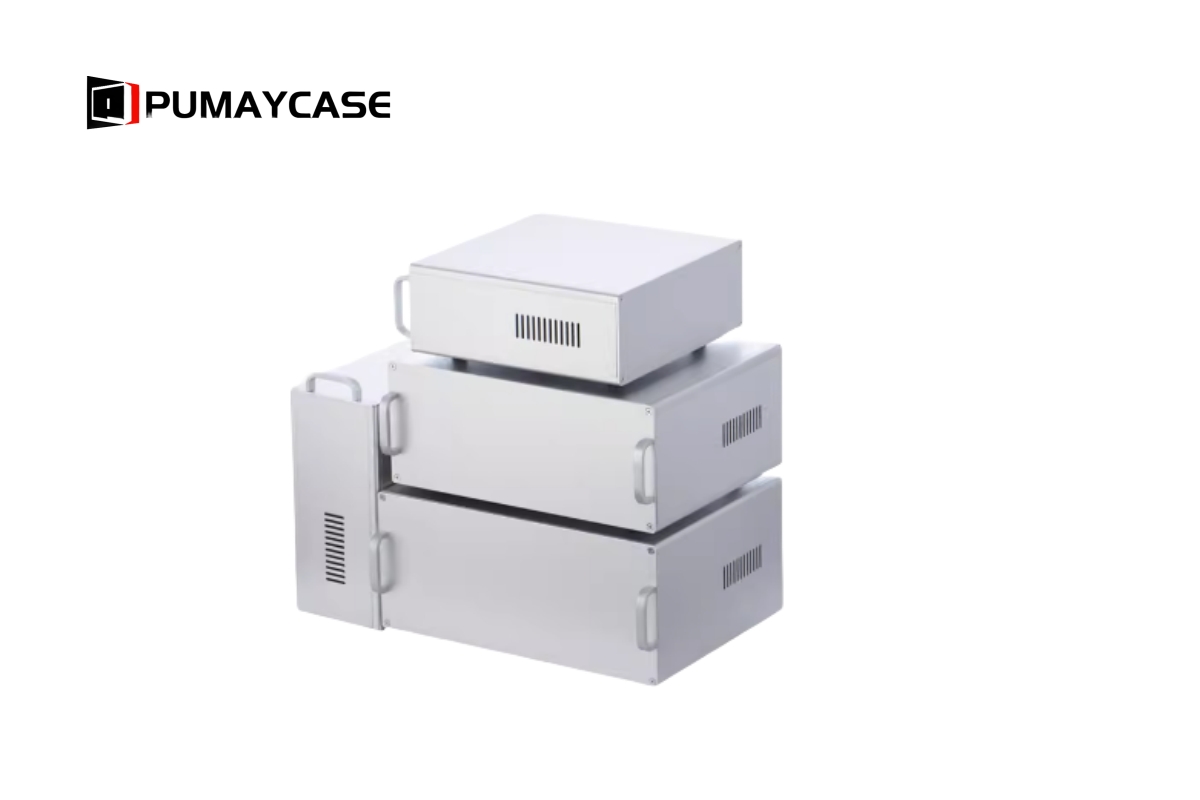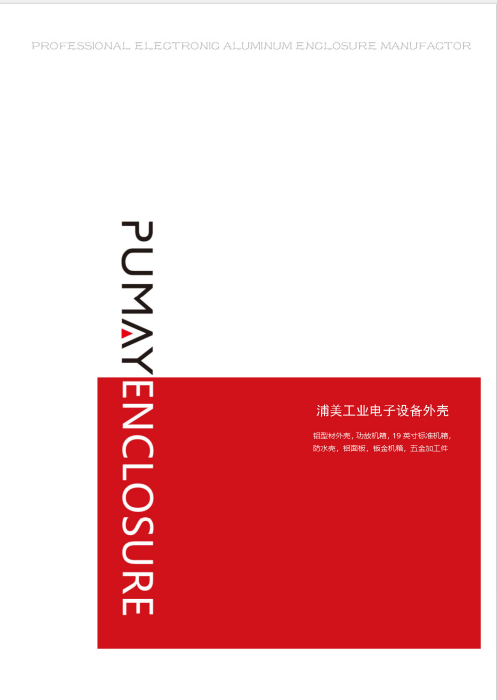Instrumentation enclosures protect sensitive equipment from environmental factors and mechanical damage while ensuring optimal performance. Selecting the right material is crucial for achieving the desired balance of durability, thermal management, corrosion resistance, and weight1.
This guide breaks down the most common materials used2 for instrumentation enclosures and their performance characteristics3, helping you make an informed choice.
1. Aluminum Alloy
Overview:\
Aluminum is one of the most popular materials for instrumentation enclosures due to its excellent combination of lightweight, strength, and corrosion resistance.
Key Features:
- Lightweight: Reduces overall equipment weight, making it ideal for portable devices.
- High Thermal Conductivity: Excellent for heat dissipation in power electronics and high-performance devices.
- Corrosion Resistance: Naturally forms an oxide layer for protection; anodizing enhances durability.
- Good EMI/RFI Shielding: Blocks electromagnetic interference, ensuring reliable operation of sensitive electronics.
Applications:
- Medical Devices
- Power Electronics (amplifiers, inverters)
- Industrial Control Systems
- Telecommunication Equipment
Surface Treatment Options:
- Anodizing: Improves corrosion resistance and aesthetics.
- Powder Coating: Adds a protective layer with customizable colors and textures.
Performance Summary:
| Property | Performance |
|---|---|
| Weight | Light |
| Corrosion Resistance | High (especially when anodized) |
| Thermal Conductivity | Excellent |
| EMI/RFI Shielding | Good |
| Cost | Moderate |
2. Stainless Steel
Overview:\
Stainless steel is known for its high strength and superior corrosion resistance, especially in harsh or outdoor environments.
Key Features:
- Corrosion Resistance: Excellent, particularly 316L stainless steel, which is suitable for marine and chemical environments.
- High Strength and Impact Resistance: Ideal for heavy-duty applications.
- Aesthetic Appeal: Polished or brushed finishes give a professional look.
Applications:
- Outdoor Instrumentation
- Food Processing and Pharmaceutical Equipment
- Marine and Offshore Applications
- Military-Grade Systems
Surface Treatment Options:
- Polishing: Improves corrosion resistance and aesthetics.
- Electropolishing: Removes surface impurities for enhanced cleanliness and passivation.
Performance Summary:
| Property | Performance |
|---|---|
| Weight | Heavy |
| Corrosion Resistance | Excellent (316L grade) |
| Thermal Conductivity | Moderate |
| EMI/RFI Shielding | Excellent |
| Cost | High |
3. Mild Steel (Carbon Steel)
Overview:\
Mild steel is often used for indoor applications where cost efficiency and strength are priorities.
Key Features:
- High Strength: Suitable for large enclosures and heavy equipment.
- Cost-Effective: Lower material cost compared to aluminum or stainless steel.
- Easily Machined and Fabricated: Supports custom designs and complex shapes.
Applications:
Surface Treatment Options:
- Powder Coating: Prevents corrosion and allows color customization.
- Galvanization: Adds a zinc layer for rust protection.
Performance Summary:
| Property | Performance |
|---|---|
| Weight | Heavy |
| Corrosion Resistance | Low (requires surface treatment) |
| Thermal Conductivity | Low |
| EMI/RFI Shielding | Good |
| Cost | Low |
4. Polycarbonate (PC) and ABS Plastics
Overview:\
Polycarbonate (PC) and ABS (Acrylonitrile Butadiene Styrene) are commonly used for non-metallic enclosures, providing excellent insulation and lightweight designs.
Key Features:
- Lightweight and Impact-Resistant: Polycarbonate offers high impact strength, while ABS is more cost-effective.
- Electrical Insulation: Non-conductive, making it ideal for low-voltage applications.
- Weather Resistance: UV-resistant grades are suitable for outdoor use.
Applications:
- Laboratory Instruments
- Portable Measuring Devices
- Low-Voltage Electrical Enclosures
Surface Treatment Options:
- UV Coating: Prevents yellowing and degradation in outdoor applications.
- Textured Finish: Reduces surface scratches and improves appearance.
Performance Summary:
| Property | Performance |
|---|---|
| Weight | Very light |
| Corrosion Resistance | Excellent |
| Thermal Conductivity | Poor |
| EMI/RFI Shielding | Low |
| Cost | Low to Moderate |
5. Composite Materials (FRP – Fiber Reinforced Plastic)
Overview:\
FRP (Fiber Reinforced Plastic) is known for its corrosion resistance, lightweight properties, and high mechanical strength.
Key Features:
- Non-Conductive: Provides excellent electrical insulation.
- High Chemical Resistance: Ideal for corrosive environments.
- Lightweight: Easier to transport and install compared to metal enclosures.
Applications:
- Chemical and Petrochemical Industries
- Marine Applications
- High-Voltage Electrical Enclosures
Performance Summary:
| Property | Performance |
|---|---|
| Weight | Light |
| Corrosion Resistance | Excellent |
| Thermal Conductivity | Poor |
| EMI/RFI Shielding | Low |
| Cost | High |
Material Selection Guide
| Material | Best For | Limitations |
|---|---|---|
| Aluminum Alloy | Lightweight, heat dissipation, EMI shielding | Moderate cost |
| Stainless Steel | Corrosive environments, outdoor use | Heavy and expensive |
| Mild Steel | Indoor industrial enclosures, cost efficiency | Requires surface treatment |
| Polycarbonate | Portable devices, non-conductive applications | Limited thermal conductivity |
| FRP | Chemical resistance, electrical insulation | High cost, low EMI shielding |
Selecting the right material for an instrumentation enclosure depends on the environment, performance requirements, and budget. Aluminum is a versatile choice for most applications due to its balance of weight, thermal efficiency, and EMI shielding, while stainless steel is essential for harsh environments. For non-metallic applications, polycarbonate and FRP offer lightweight, corrosion-resistant alternatives. Understanding the strengths and limitations of each material ensures your enclosure will provide reliable protection and long-term performance.
-
Explore this link to understand how different materials can enhance the performance and longevity of your instrumentation enclosures. ↩
-
Discover the most widely used materials for instrumentation enclosures to make an informed decision for your project. ↩
-
Learn about the performance characteristics of various materials to ensure optimal protection and functionality for your equipment. ↩
-
Explore this link to understand the latest standards and innovations in industrial equipment enclosures, ensuring optimal protection and efficiency. ↩
-
This resource will guide you through selecting the best electrical control cabinets, enhancing safety and functionality in your projects. ↩
-
Learn about the essential components and design considerations for indoor power distribution systems to improve reliability and performance. ↩



